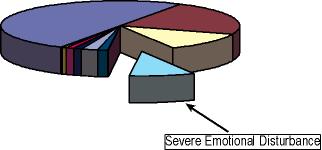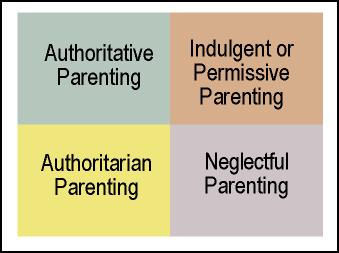| ESE424 : The Class : Mild Disabilities : Behavioral/Emotional : What | |||||
Emotional and Behavior Disorders
This topic is divided into the following content areas and subtropics:
- Information about emotional and behavioral disorders
- What are emotional and behavioral disorders?
- Incidence and prevalence of emotional and behavioral disorders
- Developmental Influences
- Attachment and bonding
- Parenting styles and emotional and behavioral disorders
- Developmental influences
- Risk and resiliancy
What is an emotional or behavior disorder and how many children have one of these conditions?
From a purely diagnostic perspective this is a simple task. Several definitions
exist to assist us in this task. The one you will need to commit to memory
the federal definition included in the IDEA. IDEA defines an emotional
or behavioral disorder as a "serious emotional disturbance."
According to this definition....
"(i) The term means a condition exhibiting one or more of the following characteristics over a long period of time and to a marked degree that adversely affects a child’s educational performance:
- (A) An inability to learn that cannot be explained by intellectual, sensory, or health factors.
- (B) An inability to build or maintain satisfactory interpersonal relationships with peers and teachers.
- (C) Inappropriate types of behavior or feelings under normal circumstances.
- (D) A general pervasive mood of unhappiness or depression.
- (E) A tendency to develop physical symptoms or fears associated with personal or school problems.
(ii) The term includes schizophrenia. The term does not apply to children who are socially maladjusted, unless it is determined that they have an emotional disturbance" (CFR §300.7 (a) 9).
Thus, emotional and behavioral disorders can consist of many different conditions, including:
- anxiety (including fears or phobias)
- depression
- conduct disorders (more frequently called "acting out behaviors")
- schizophrenia or psychosis
An unfortunate perception.
The definition above gives us some guidelines about emotional and behavioral disorders. Unfortunately, this definition comes with some baggage -- our perceptions of a "disorder." When think of these disturbances or disorders, we often consider it to be something "bad" for a person. Much like with a central nervous system disorder, we generally think of adverse effects the person may experience (difficulty walking, communication impairment, and possibly visual or hearing problems). A similar perception is evident when most people think about a person with an emotional or behavioral disorder. The outcome of this disorder is disruptive behavior, psychotic thoughts, or aggression. This perception, however, is limiting and can be counterproductive It can be argued that an emotional or behavioral disorder is better viewed as a person's reactions to their environment(s) rather than a dysfunction within the individual. Using this perspective, the focus shifts from the person to the interaction between the person and the environment. A person may not have an organic reason for their behavior but nevertheless demonstrate a behavior disorder.
For there to be a disorder, there must also be an established standard that describes what is acceptable or healthy, and a decision about how the person's behaviors match that standard. As much as the definition - and some feel more so - the comparisons of behavior to standards of conduct, whether over or covert, determines whether a person has an emotional or behavioral disorder. In many instances, behavior and emotion are judged according to cultural or situational standards, gender norms, behavioral considerations, and developmental levels. You should remember that these standards are hardly stable, often changing over a relatively short period of time to accommodate new patterns of behavior. What standards do we use to judge emotional or behavioral disorders?
Variables that effect our judgments about emotional and behavioral disorders

Click on each variable for more information
Prevalence of emotional and behavioral disorders
Given this information about definitions and standards, we can now review information about how many children have an emotional or behavioral disorder. The chart below represents the percentage of students who are receiving special education (about 10 % of the school population). I have extracted the piece that represents those children with emotional or behavioral disorders. You can see that children with an emotional and behavioral disorder comprise only a small portion of this group of overall special education population (about 8.9%).

Other data suggest that the overall prevalence of emotional and behavioral disorders in clinic-level settings may be as high as 15-20%. Of these, some professionals feel that less than 1/3 of the children in need of treatment are in fact receiving services sufficient to overcome their disorders (Weist, 1997). Given these figures, you would expect to have a significant number of children with emotional and behavioral disorders in our schools, yet this is not the case.
This prevalence is further altered for different age groups and gender.
Developmental Context
In this section we will look at several factors that influence whether a child will develop an emotional or behavioral disorder. This is obviously a very complex, multifactoral process. The child's behavior may stem from multiple causes - physical, psychological, sociocultural. Most often these work in combination to produce the emotional or behavioral disorder. To fully understand this process it is important to examine as many of these as possible. Here we will look at early family attachments, developmental influences, and risk and resiliancy factors. This list is by no means comprehensive.
Early Family Attachments
Early attachment is considered to be important because these behaviors have been shown to be highly related to later behavior (Wicks-Nelson & Israel, 1999). Studies have documented that insecure infant attachment is a risk factor for developing later emotional or behavioral disorders. Early researchers studying infant development and parent-child bonding identified three general patterns of parent-child attachments:
- secure attachment - the child displays warmth, happiness, and high levels of interaction
- ambivalent - the child shows inconsistent interaction patterns or does not appear to bond well with the parent.
- avoidant - the child does not bond and avoids interactions or engages in negative interaction patterns.
To this list, we can add one more pattern - a pattern that has very serious implications for children with emotional and behavioral disorders
- disorganized - disoriented - the pattern of interaction and bonding is characterized by inconsistent and unpredictable interactions.
The specific pattern of attachment is dependent on the parent behavior, the child behavior, and life circumstances.
The data from these and other child-parent attachment studies also clearly show that a child who is exposed to pathological, abusive caretaking will show disorganized or disoriented attachment behaviors such as:
- excessive social withdrawal -or-
- excessive sociability where the child attaches to relative strangers
Parent-Child Reciprocal Social Interactions
How parents interact with their children is also related to whether children develop emotional or behavioral disorders. The style of parenting correlates with the behavior children will exhibit. In addition, the behavior that a child exhibits will influence how parents interact with their children. This reciprocal social interaction pattern has been shown to produce certain predictable behaviors in children and adults.
A study by Maccoby and Martin (1983) identified four basic parenting patterns. These are illustrated in the graphic below. Click on each term to learn about the parenting pattern and the types of child behavior that are associated with each.

Developmental Influences
Why is it that some children who grow up in difficult or abusive situations, who have a family history of emotional illness, who did not attach to their parents do not develop an emotional or behavioral disorder? This is a question that has plagued researchers for some time. All these factors are correlative not causative. It appears that there are more factors that may influence whether a child actually develops an emotional or behavior disorder. Four are important for this lesson:
- normative vs. non-normative influences
- Some influences (death of a family member, missing family members) occur for only some people and at unpredictable times. Non-normative influences may trigger emotional and behavioral disorders.
- necessary and/or sufficient causes
- Some correlative factors (e.g., parenting style) are necessary, that is they are highly associated with a condition, but are not sufficient. Something else must co-occur to trigger an emotional or behavioral disorder.
- direct and indirect influences
- Some factors we have discussed are direct - they cause a problem behavior. Other factors are indirect. They affect another variable (parent supports) that in turn cause a child to display an emotional or behavioral disorder.
- the timing of the influence
- Lastly, the timing of the event is particularly important. If a stressful event (the loss of a sibling) occurs in a setting or time period where other supports (grandparents are present in the home, the child is supported by a good peer group) are available, the impact is not nearly as significant as if it were to occur when the supports are not available.
Risk and Resiliancy Factors
We have reviewed a host of potential risk factors, variables that increase a child's risk of developing a behavioral or emotional difficulty- family interaction patterns, parenting practices, developmental influences. You have also read about biological or organic risk factors. Each of these place a child in a position where they are more susceptible to developing an emotional or behavioral disorder. What prevents children from developing these conditions?
Risk Factors
Resilancy Factors
Resiliancy factors are variables that protect a child from the influence of these risk factors or allow the child to "bounce back" when faced with adversity. If you examine your life you will find many resiliance factors that have helped you throught the tough times. Children with emotional or behavioral difficulties are no different except that, chances are, they did not have access to these supports at a critical time in their life.
Resiliancy Factors
- Personal Attributes -
- intelligence, self-esteem, easy going temperament, self-discipline, social skills
- Family Attributes -
- affection and support of parents and other family members (nuclear and extended)
- peer support and acceptance of peers by family members
- Support Outside the Home -
- peers, school, churches, community organizations, big brothers/big sisters, mentors, work, sports
Once you have finished you should:
Go on to Activity
2: Perspectives on Emotional and Behavioral Disorders
or
Go back to Emotional
and Behavioral Disorders
E-mail Larry Gallagher at Larry.Gallagher@nau.edu
Copyright © 2000 Northern Arizona
University
ALL RIGHTS RESERVED